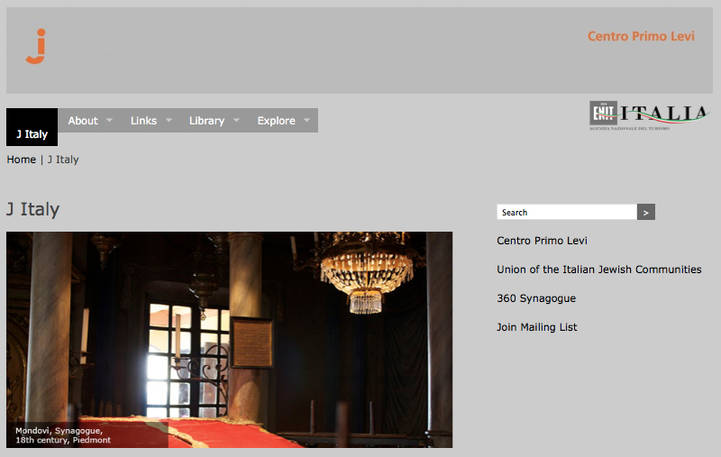


Over two hundred people attended the presentation Jewish Treasures of the Italian Regions at Casa Italiana Zerilli Marimò, where Riccardo Strano, director of ENIT [2] (Italian Government Tourist Board), Natalia Indrimi, executive director of Centro Primo Levi [3], Jonathan Wajskol, owner of designwajskol [4] and Francesco Spagnolo, professor of the University of California, Berkeley [5], introduced the new portal J-Italy (www.j-italy.org [6]).
J-Italy, conceived by Centro Primo Levi in collaboration with ENIT and UCEI [7](The Union of Italian Jewish Communities) and designed by Jonathan Wajskol, provides a dynamic guide to both historical and contemporary Jewish Italy, allowing viewers to explore, at their own pace, the cultural treasures of the most ancient Diaspora community in the West. Region by region, it highlights both famous and lesser known sites thereby presenting a three-dimensional panorama of a complex history of migrations, persecutions, prosperity and achievement.
Geographic as well as cultural itineraries bring forth the connections and interactions between Italian Judaism, Italian society and the world at large. J-ITALY is designed for English-speaking tourists, students and all those interested in a comprehensive view of the variety of Jewish experiences in Italy across history. From the Alps all the way to Sicily the Italian Jewish experience spans over twenty centuries with a remarkable tradition of diversity among its regional components.
The aim of the portal is to build on the wealth of information selected from a variety of sources - books, archives, organizations and institutions - that make up the heterogeneous world of Italian Judaism. J-ITALY brings together resources previously not available in one location, providing a journey of constant discovery for those who navigate it.
According to Riccardo Strano “J-Italy is a project of great cultural impact. We created a sort of cultural and touristic bridge to showcase Jewish treasures in Italy by means of a virtual tour. Navigating the web site, international travelers as well as anyone interested will learn about each Italian region, and the vivid and tangible history of the Jewish Communities that have lived there uninterruptedly for 20 centuries. With J-Italy we would like to extend travelers an invitation to enhance their knowledge of a Jewish Italy, encourage them to visit museums and synagogues, experience the contemporary life style of the Italian Jewish population and enjoy the flavor of their delicious cuisine. J-Italy is a formidable promotional tool geared towards individuals as well as travel professionals (agents, tour operators and travel writers) to increase their knowledge of Italian Jewish heritage.”
“Every Italian region has a vast Jewish heritage,” Natalia Indrimi said, “and often we have been contacted, through ENIT, by individual regions in need to organize something here in New York. Through the years we have realized that this requires a lot of effort and it is difficult to create something that is everlasting. The idea of Centro Primo Levi is to create a cultural interface that is solid and reusable. We want other centers and cultural organizations to use it too. It has to be a platform for any kind of promotion. For example, recently the inscriptions in the Venosa catacombs in Basilicata were decoded. It is difficult to have access to this type of information without a platform whose purpose is to bring Jewish culture to an American readership.”
Two regions, Marche and Puglia, were the first to be completed on the portal and the two that were presented at Casa Italiana. Professor Spagnolo presented their musical history, as music, as well as other cultural aspects of life in Puglia and local folklore are intertwined with Jewish history. “From a cultural point of view, Jewish sites in Puglia have great significance,” Silvia Godelli. Assessore alla Cultura e al Turismo for the Regione Puglia said, “They are a proof and a reminder of a Jewish presence in this region which lasted approximately 1500 years, and after a long interruption is now surprisingly coming back to life, albeit in very small numbers.” Godelli is referring to the Jewish resurgence in the city of Trani where, unprecedented in Europe, the ancient Jewish community is being revived by recent converts. “As far as tourism is a concerned, Jewish sites appeal mostly to motivated individuals (many of them American Jews), fascinated by the possibility to trace the places where one of the most ancient Jewish communities in the Mediterranean once flourished.”
Viewers can explore Jewish Italy through location, period and typology, “The paths are many,” Natalia Indrimi added, “yet the story is one, a complex history of migrations, persecutions, prosperity and achievement.”
Source URL: http://test.casaitaliananyu.org/magazine/focus/life-people/article/introducing-j-italy
Links
[1] http://test.casaitaliananyu.org/files/j-italy1316317452jpg
[2] http://www.enit.it
[3] http://www.primolevicenter.org/
[4] http://www.wajskol.com/
[5] http://berkeley.edu/
[6] http://www.j-italy.org
[7] http://www.ucei.it/